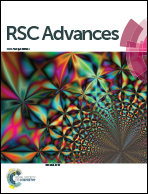P3HT-based visible-light organic photodetectors using PEI/PAA multilayers as a p-type buffer layer†
Abstract
A low leakage current is critical for achieving organic photodetectors (OPDs) with high detectivity. The insertion of buffer layers is an effective approach for reducing the reverse-biased leakage current. In this study, polyelectrolyte multilayers comprising polyethyleneimine (PEI) and polyacrylic acid (PAA) were introduced by a spin-assisted layer-by-layer technique into an OPD as a p-type buffer layer. Although PEI/PAA multilayers are insulators, when used as a buffer layer in our device, they suppressed the leakage current and also provided a high photocurrent due to the light-assisted tunneling effect. The prepared device configuration was ITO/(PEI/PAA)2/P3HT:PC60BM/Yb/Al. The performances of the OPDs were investigated by measuring the current–voltage characteristics, external quantum efficiency, and transient photocurrent. In addition, the operating mechanism of the OPDs was confirmed by impedance analysis. The device comprising (PEI/PAA)2 showed a specific detectivity of 3.11 × 1012 Jones and a bandwidth of 103.2 kHz at −1 V and 525 nm. This performance is a numerical value that can be used in devices such as a line scan camera. In addition, because this device is fabricated by a low-temperature solution process, flexible and large-area substrates can be used.



 Please wait while we load your content...
Please wait while we load your content...